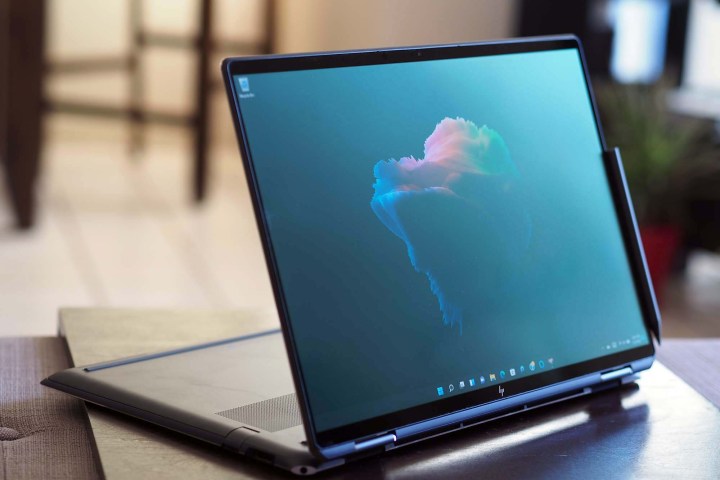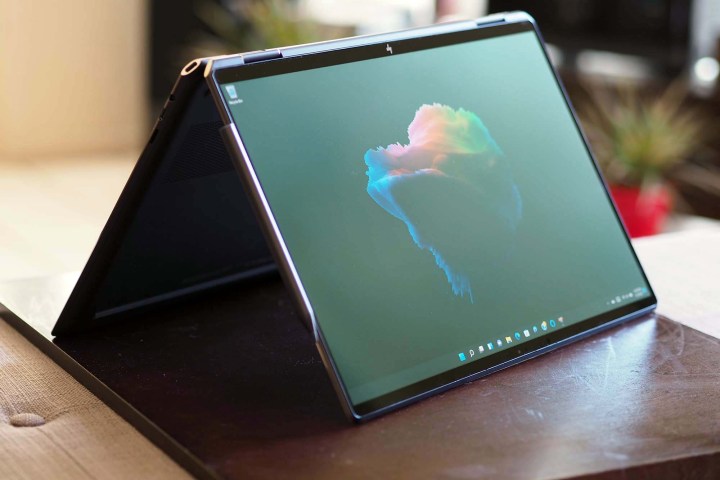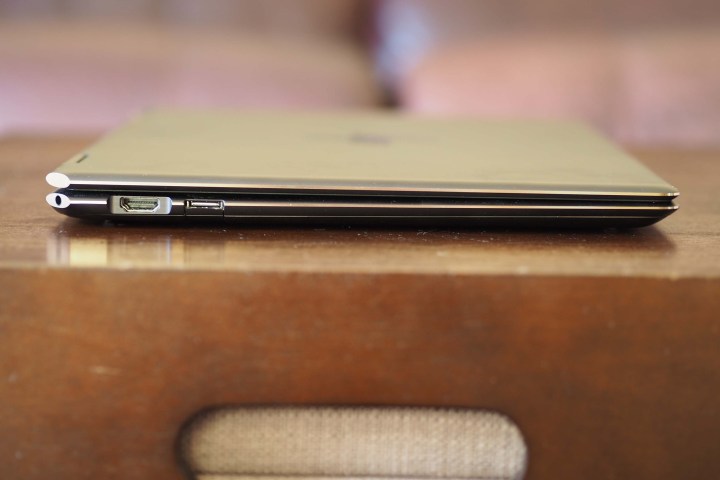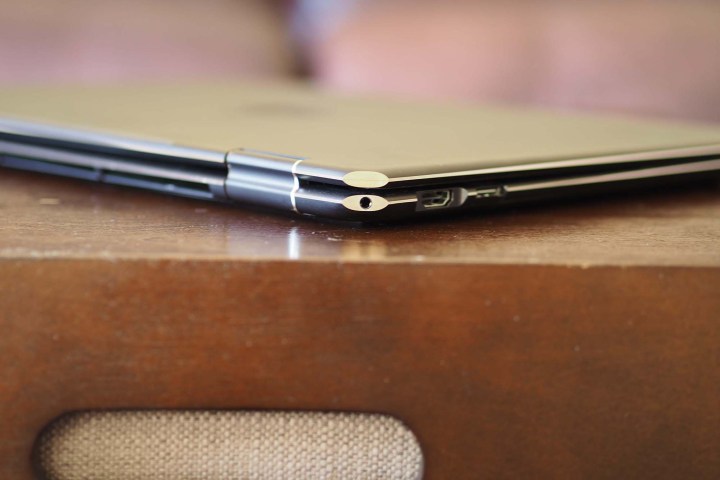- Solid productivity performance
- Excellent build quality
- Spectacular OLED display
- Outstanding keyboard and touchpad
- Elegant good looks
- Creative performance is lacking
- Large and heavy in tablet mode
HP’s Spectre x360 15 has been one of our favorite convertible 2-in-1s for a while now, but it’s design was getting a bit long in the tooth.
HP’s replacement is the Spectre x360 16, a slightly larger 2-in-1 with a 16:10 display and some significant design changes to the iconic Spectre gem-cut design. The only problem? It missed the upcoming wave of Intel 12th-gen Core or AMD Ryzen 6000 updates, which gives it an uphill climb as we head into 2022.
I reviewed the high-end $2,030 configuration of the Spectre x360 16 with a 35-watt Core i7-11390H, Nvidia RTX 3050 GPU, and a 16-inch 4K+ (3,840 x 2,400) OLED display. It’s a beautiful, high-end laptop for sure, despite the shortcomings in performance.
Design

HP toned down its gem-cut aesthetic with the Spectre x360 16, simplifying the edges and rounding out the notches cut in each corner of the chassis and display. My Nightfall Black review unit still enjoys Pale Brass accents along the edges, hinges, and the framing around the touchpad, but they’re far more subtle than on the Spectre x360 15. There’s also a Nocturne Blue chassis with Celestial Blue accents.
The edges are tapered to be thin enough now that the USB-A port requires a drop-jaw mechanism to fit in place. I like the fresh look, finding it more elegant while still standing out. The MSI Summit E16 Flip has a similar color scheme, although it’s not as rounded and it lacks HP’s refinement.
Thanks to the use of CNC-machined aluminum, it’s solid as a rock.
The Spectre x360 16 is a large 2-in-1 thanks to its 16-inch 16:10 display. It’s quite a bit deeper than the Spectre x360 15 while being slightly less wide, and it’s 0.78 inches thick compared to 0.79 inches for its predecessor and 4.45 pounds compared to 4.24 pounds. The MSI Summit E16 Flip, another large convertible 2-in-1, is just 0.67 inches thick and weighs a similar 4.4 pounds.
The Spectre x360 16 is manageable in clamshell and media modes, but tent and tablet modes are cumbersome. You’ll want to lay the laptop on a solid surface when using it as a tablet with the included active pen.
One thing that hasn’t changed from the previous model is the Spectre x360 16’s build quality. Thanks to the use of CNC-machined aluminum, it’s solid as a rock, with no bending or flexing anywhere in the lid, keyboard deck, or chassis. It’s equal to the best laptops on the market, such as Dell’s XPS 15, and it maintains the Spectre line’s high standards.
HP implemented the second generation of its thermal management with the Spectre x360 16, naming it Intelligent Smart Sense 2.0, and it’s intended to improve performance by automatically optimizing performance versus fan noise and chassis heat. The company’s in-bag detection is now in its second generation as well, promising to avoid the laptop waking up and overheating in a backpack
Connectivity is decent, with two USB-C with Thunderbolt 4 ports (one of which is conveniently located in the notch at the rear of the chassis), a full-size HDMI 2.0b port, a USB-A 3.2 Gen 2 port, a microSD card reader, and a 3.5mm audio jack (located in the other notch). Power is provided by a proprietary 130-watt charger connection, leaving both USB ports for connecting peripherals. Wireless connectivity is fully up to speed at Wi-Fi 6E and Bluetooth 5.2.
Performance
The Spectre x360 16 missed out on an Intel 12th-gen upgrade by several months, and instead relies on a 35-watt, four-core/eight-thread Core i7-11390H. That CPU sits in-between Intel’s 11th-gen U-series and 45-watt H-series processors. There’s also an Nvidia GeForce RTX 3050 on hand, an entry-level GPU, and you can save several hundred dollars by opting for integrated Iris Xe graphics.

Overall, the Spectre x360 16 is underpowered compared to some other laptops in the same 15- and 16-inch class. Indeed, it didn’t always keep up with the Spectre x360 15 that utilized a 1oth-gen Core i7-10750H and an Nvidia GeForce 1650 Ti.
In Geekbench 5, the Spectre x360 16 was the slowest in our comparison group, at least in multi-core mode, even falling behind the LG Gram 16 with its Core i7-1165G7. I’ll note here that HP has its Command Center utility that can switch performance between the automated Smart Sense, which I didn’t use, and Balanced, Performance, and Cool modes. I ran all the benchmarks in both Balanced and Performance modes and recorded the Balanced results here. Performance mode does make a difference, bumping the Geekbench score to a slightly more competitive 5,278 in multi-core mode.
Its performance is sure to be further eclipsed once Intel’s 12th-gen CPUs start rolling out.
In our Handbrake test that encodes a 420MB video as H.265, the Spectre x360 16 was well behind the rest of the group, including the Spectre x360 15. Performance mode produced a stronger 177 seconds, still the second-slowest showing. The Spectre x360 16 did a little better in Cinebench R23, beating out the Spectre x360 15, but falling way behind laptops equipped with 45-watt CPUs.
Again, Performance mode gave a stronger showing at 6,328 in multi-core mode. I also ran the Pugetbench benchmark that operates within a live version of Adobe Premiere Pro, and the Spectre x360 16 was once again underwhelming. It beat its predecessor but was considerably slower than the rest of the group at 378 (416 in Performance mode).

Finally, in PCMark 10 Complete, the Spectre x360 16 came in at third-slowest. Its scores across the various PCMark 10 categories, including Essentials, Productivity, and Content Creation, were in line with this result. Performance mode made less of a difference in this benchmark.
The bottom line is that the Spectre x360 16 is a fast-enough performer that it can handle demanding productivity workflows, and perhaps that’s HP’s target. But it’s not up to par with some other similarly sized laptops for creative applications. And its performance is sure to be further eclipsed once Intel’s 12th-gen CPUs start rolling out.
| Laptop | Geekbench 5 | Cinebench R23 | Pugetbench Premiere Pro | Handbrake (seconds) |
PCMark 10 | 3DMark Time Spy | Fortnite (1080p Epic) |
Civilization VI (1080p Ultra) |
| HP Spectre x360 16 (Core i7-11390H) | 1506 / 4938 | 1547 / 5562 | 378 | 233 | 5110 | 3453 | 37 fps (1200p) | 58 fps |
| HP Spectre x360 15 (Core i7-10750H) | 1237 / 5013 | 1102 / 5492 | 339 | 160 | 4676 | 2325 | 54 fps | 60 fps |
| MSI Summit E16 Flip (Core i7-1195G7) | 1607 / 6096 | 1589 / 5344 | 552 | 175 | 5681 | 4138 | 52 fps | 62 fps |
| Dell XPS 15 OLED 2021 (Core i7-11800H) | 1544 / 7692 | 1513 / 9979 | 509 | 101 | 6024 | 4540 | 50 fps | 73 fps |
| MSI Creator Z16 (Core i7-11800H) | 1540 / 7625 | 1444 / 9615 | 738 | 103 | 6486 | 6322 | 59 fps (1200p) | 92 fps |
| LG Gram 16 (Core i7-1165G7) | 1573 / 5454 | 1394 / 4137 | N/A | 213 | 4827 | 1390 | 13 fps | n/a |
The Spectre x360 16 just barely scratches the entry level as a gaming laptop. It struggled to keep up with any of the laptops in our comparison groups with discrete graphics, many of which used previous-generation GPUs. The MSI Summit E16 Flip also equipped an RTX 3050, and it was faster across almost all our benchmarks. In Fortnite, for example, running at 1200p and epic graphics, the Spectre x360 was slower than all but the LG Gram 16 with its Intel Iris Xe.
It was atrocious in Assassin’s Creed Valhalla, hitting just 11 frames per second (fps) at 1200p and high graphics compared to the Summit E16 Flip that hit 43 fps. I didn’t bother running the game at higher resolutions or graphical settings. The Spectre x360 16 did better in Battlefield V, matching the Summit E16 Flip at 49 fps at 1200p and medium graphics. Note that performance mode added just a few frames per second in each of the games I tested.
Display
The 16:10 4K+ OLED display is the Spectre x360 16’s center of attraction, and it was stunning from the moment I turned it on. Colors popped, blacks were inky, and brightness was sufficient for all but working outside in the Southern California sun. As with all OLED displays, I was enjoying the view. HP also offers a 3K (3072 x 1920) IPS panel if you want to save some cash.

I used my colorimeter to confirm my subjective impressions. Brightness was good at 354, above our threshold of 300 nits for overcoming harsh indoor lighting. The Spectre x360 15’s OLED display was brighter at 426 nits, as was the Dell XPS 15 OLED’s panel at 397 nits. The contrast was excellent at 27,590:1, which is essentially equal to the Spectre x360 15 and XPS 15 OLED displays. Colors were wide at 100% of sRGB and 97% of AdobeRGB, with an accuracy of DeltaE 0.89 (1.0 or less is considered excellent).
That compares to the Spectre x360 15 at 100%, 98%, and 1.21, and the XPS 15 OLED at 100%, 97%, and an even better 0.41. One of the best IPS displays, Dell’s XPS 15 4K panel, can match most of these results at 442 nits, 100% of both sRGB and AdobeRGB, and an accuracy of 0.65. However, its contrast comes in at 1,480:1, well below the OLED displays, even while excelling for IPS.
There’s nothing to complain about with the Spectre x360 16’s display. It’s large, high-res, and dynamic, and it will delight productivity workers and creative professionals alike. Media consumption is pretty great as well.
Four speakers, two downward-firing at the front underside of the chassis and two upward-firing on each side of the keyboard, power the audio system. Tuned by Bang and Olufsen, the sound quality was excellent, with plenty of volume, some bass, and clear mids and highs. The Dell XPS 15 and MacBook Pro still have better audio, but the Spectre x360 16 was close enough. The audio was acceptable enough for bingeing Netflix and listening to tunes without pulling out a pair of headphones.
Keyboard and touchpad

The Spectre x360 16 retains the same excellent keyboard as its predecessor, except HP dropped the numeric keypad and instead bracketed the keyboard with the extra set of speakers. The numeric keypad was a bit of a niche feature and likely won’t be missed by that many users. The keyboard’s switch mechanism was as precise as always, with a subtle click and a wonderfully comfortable bottoming action.
It’s also a light keyboard, which I find helps with long typing sessions (like writing this review). Only the keyboard used on Dell’s XPS line rivals the Spectre x360 16’s in the Windows world, and only Apple’s latest MacBook keyboard is better. In any event, it’s an excellent keyboard that will please fast touch typists.
The touchpad has been enlarged by 39% over the Spectre x360 15’s wide version, and that’s a welcome change. It’s finally large enough to take up most of the available space on the palm rest, and it’s responsive and accurate thanks to Microsoft Precision touchpad drivers. The buttons have a firm but quiet click that won’t bother anybody working nearby.

The touch display supports HP’s active pen, which is included in the box and magnetically attaches to the right side of the lid. The display responded precisely to both finger and pen input, providing an excellent platform for Windows Ink.
Security, privacy, and ergonomics

Some new technology on hand utilizes the 5MP webcam and infrared camera to enhance security and privacy. Like with some Lenovo laptops, the Spectre x360 16 now has a feature called “walkaway lock” that locks and sleeps the laptop when the user steps away, and another called “wake on approach” that wakes and unlocks the laptop when the user returns. The feature worked well in my testing and added some convenience and security, ensuring you don’t forget to lock your laptop if you leave it alone in a public setting.
A new Attention Tracking feature dims the screen when the user looks away; it’s not a security or privacy feature, but a nice touch nonetheless. Then there’s “Shoulder Surfing,” which can blur your display when someone looks over your shoulder. Finally, the Spectre x360 16 can tell you when your face is too close to the screen for comfort, and it can track the amount of time you spend on the machine and alert you when limits are met.
All these features are found, somewhat confusingly, in the “GlamCam” menu item in the HP Command Center. GlamCam is the name given to some technologies, like Beauty Mode, that can smooth out wrinkles and remove blemishes to provide you with a nice Photoshopped-like videoconference appearance. There’s also Auto Frame, which keeps you in the center of the video frame as you move around, and Lighting Correction that optimizes the image for the environment.

None of these features have been available on previous Spectre models, and they’re all welcome additions for those who value their security, privacy, and eyesight. Note that the same keyboard button as on other recent Spectres is used to physically close the webcam for some additional privacy, and Windows 10 Hello support is provided by both an infrared camera with facial recognition and a fingerprint reader located in place of the right ctrl-key. Both methods worked flawlessly.
Battery life

There are 83 watt-hours of battery packed inside the Spectre x360 16’s chassis, a considerable increase from the 73 watt-hours in the Spectre x360 15. The drop in CPU wattage should also contribute to an increase in battery life over its predecessor. And that’s precisely what I saw in my testing.
I was impressed with the Spectre x360 16’s battery life.
In our web-browsing test that cycles through a series of popular and complex websites, the Spectre x360 16 lasted for 9.75 hours, a strong score for a laptop with a massive OLED display. The Spectre x360 15 only managed six hours on this test, while Dell’s XPS 15 OLED came in at nine hours with its 86 watt-hour battery. The Spectre x360 16 made it to 13 hours in our video test that loops a local 1080p movie trailer, another very good score that beat out the Spectre x360 15’s meager 6.5 hours and the XPS 15 OLED’s 11 hours.
Unfortunately, the Spectre x360 16 wouldn’t complete the PCMark 10 Applications battery test, the best indication of productivity battery life. It did finish the PCMark 10 Gaming battery test that demonstrates how hard a laptop works while unplugged, hitting an average 1.5 hours.
I was impressed with the Spectre x360 16’s battery life. It lasted longer than I expected given the OLED display, and it trounced the Spectre 360 15. Once again, the Spectre x360 16 demonstrated its suitability for productivity workflows — it should last for an entire workday on a single charge unless you’re really pushing the CPU.
Our take
The HP Spectre x360 16 is a very well-built and attractive convertible 2-in-1, offering a spectacular OLED display, an excellent keyboard and touchpad, and good productivity performance. Judging by just those measures, it’s a solid alternative as a large-format 2-in-1.
The only concern is that many people buy large laptops for creative work, and the Spectre x360 16 underwhelms in this arena. It’s also using last year’s CPU, and it will fall even further behind in performance once laptops with Intel’s 12th-gen processors start rolling out. That doesn’t make it an unworthy purchase by any means, and there’s not a better 16-inch 2-in-1 on the market today. It’s just something to keep in mind as you pull out your credit card.
Are there any alternatives?
The MSI Summit E16 Flip is an interesting alternative. It also sports an excellent 16-inch 16:10 IPS display, although it can’t match the Spectre x360 16’s OLED’s contrast. It performs well and has decent battery life, but again it can’t quite match the Spectre x360 16.
If you aren’t looking for a convertible 2-in-1, the Dell XPS 15 OLED is a great option. It has similar build quality, an equally good display, and its performance is better for creative workflows. It’s slightly more expensive, however.
How long will it last?
The Spectre x360 16 is an extremely well-built laptop and should last for years of abuse. Its CPU is a bit behind the curve with Intel’s 12th-gen processors coming soon, but it should still keep Windows 11 humming along for quite some time. The one-year warranty, an industry standard, is disappointing as usual.
Should you buy it?
Yes. Buy the Spectre x360 16 for its display, keyboard and touchpad, and solid productivity performance. Just don’t expect it to keep up with the leaders in creative applications.








